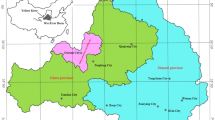Abstract
By combining a sewer defect database and hydrogeological information, it has been attempted to assess sewer–groundwater interaction at the scale of the city of Rastatt (SW-Germany). Comprehensive hydrochemical samplings, including a series of new marker species, have been conducted in the urban aquifer and used for validation. The iodated X-ray contrast media, amidotrizoic acid and iothalamic acid, can be considered as highly specific for wastewater influence and have been found in several groundwater observation wells.






Similar content being viewed by others
References
ATV-M143E (1999) Advisory leaflet—inspection of sewers and drains, part 2: optical inspection. ATV-DVWK, Hennef
Bau M, Dulski P (1996) Anthropogenic origin of positive gadolinium anomalies in river waters. Earth Planet Sci Lett 143:245–255
Baus Ch (2002) Vorkommen von iodierten Röntgenkontrastmitteln und ihr Verhalten bei der Trinkwasseraufbereitung. DVGW-TZW, Karlsruhe, Veröff. Technologiezentrum Wasser 18, pp 13–30
Dohmann M, Decker J, Menzenbach B (1999) Untersuchungen zur quantitativen und qualitativen Belastung von Boden-, Grund- und Oberflächenwasser durch undichte Kanäle. In: Dohmann M (ed) Wassergefährdung durch undichte Kanäle—Erfassung und Bewertung, Springer, Berlin Heidelberg New York, 306 pp
Eiswirth M (2002) Bilanzierung der Stoffflüsse im urbanen Wasserkreislauf—Wege zur Nachhaltigkeit urbaner Wasserressourcen. Postdoctoral lecture qualification, University of Karlsruhe
Eiswirth M, Hötzl H (1997) The impact of leaking sewers on urban groundwater. In: Chilton J (ed) Groundwater in the urban environment. Problems, processes and management, vol 1. Balkema, Rotterdam, pp 399–404
Möller P, Dulski P, Bau M, Knappe A, Pekdeger A, Sommer-von Jarstedt C (2000) Anthropogenic gadolinium as a conservative tracer in hydrology. J Geochem Explor 69–70:409–414
Osswald J (2002) Hydrogeologische und hydrochemische Zustandsbeschreibung Rastatts im Hinblick auf anthropogene Beeinflussung. Diploma Thesis, University of Karlsruhe, 169 pp
Sacher F, Lange T, Brauch H-J, Blankenhorn I (2001) Pharmaceuticals in groundwaters—analytical methods and results of a monitoring program in Baden-Württemberg, Germany. J Chromatogr A 938(1–2):199–210
Ternes Th, Hirsch R (2000) Occurrence and behaviour of x-ray contrast media in sewage facilities and the aquatic environment. Environ Sci Technol 34:2741–2748
Vollertsen J, Hvitved-Jacobson T (2002) Exfiltration from gravity sewers: a pilot scale study. Water Sci Technol 47(4):69–76
Von Keitz S (ed) (2002) Handbuch der EU-Wasserrahmenrichtlinie. Erich-Schmidt, Berlin, 447 pp
Wolf L, Held I, Eiswirth M, Hötzl H (2004) Environmental impact of leaky sewers on the groundwater quality beneath a medium sized city. Acta Hydrochim Hydrobiol 32(4–5):361–373
Acknowledgments
This work has been supported by the German Science Foundation (DFG) within the research group “Risk potential from leaky sewers for soil and groundwater”. Additional funding has been provided by the European Union in the frame of the AISUWRS project. Furthermore, the authors express their thanks to V. Tropf, J. Kramp, and P. Polak from the city of Rastatt for fruitful collaboration, Prof. Möller from GFZ Potsdam for taking and measuring gadolinium samples, and I. Held from the University of Karlsruhe for good co-operation within the project. PD Dr. Matthias Eiswirth died in an accident following the submission of this document. With him a tireless initiator of urban hydrogeological research and a good friend was taken from our community far before his time. We will keep him in our memories and remain thankful for everything he has given us.
Author information
Authors and Affiliations
Corresponding author
Additional information
M. Eiswirth deceased
Rights and permissions
About this article
Cite this article
Wolf, L., Eiswirth, M. & Hötzl, H. Assessing sewer–groundwater interaction at the city scale based on individual sewer defects and marker species distributions. Environ Geol 49, 849–857 (2006). https://doi.org/10.1007/s00254-006-0180-x
Received:
Accepted:
Published:
Issue Date:
DOI: https://doi.org/10.1007/s00254-006-0180-x




